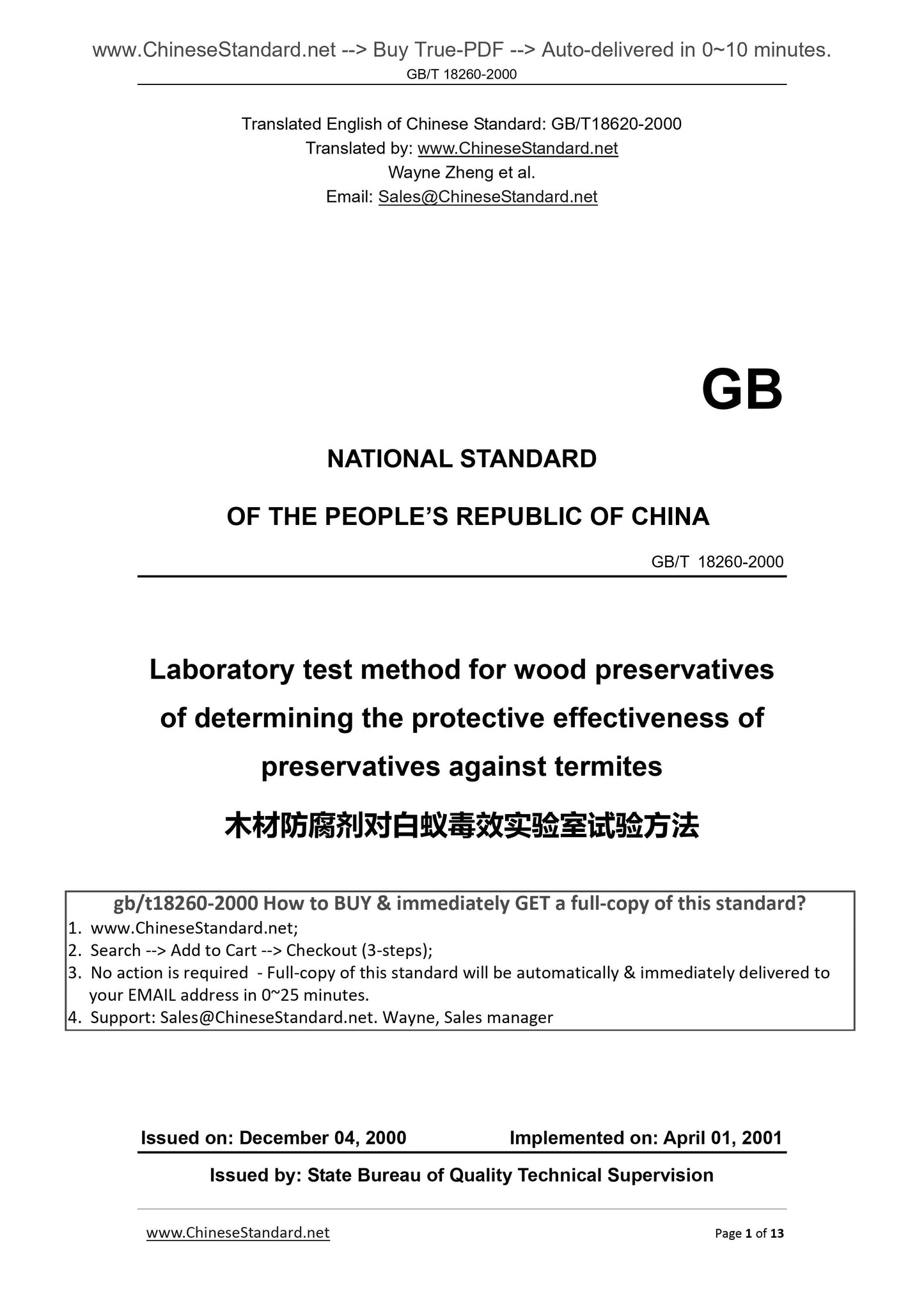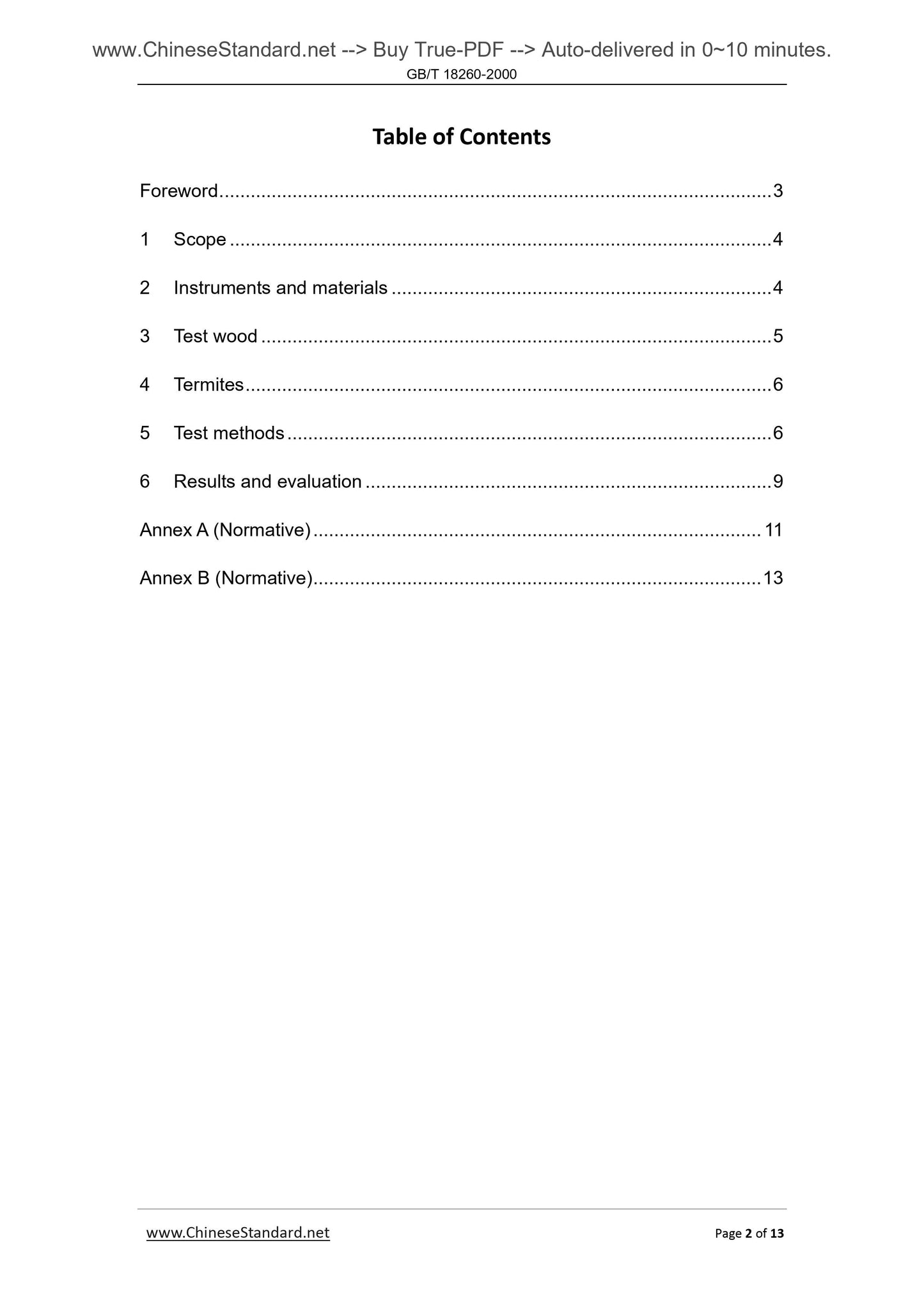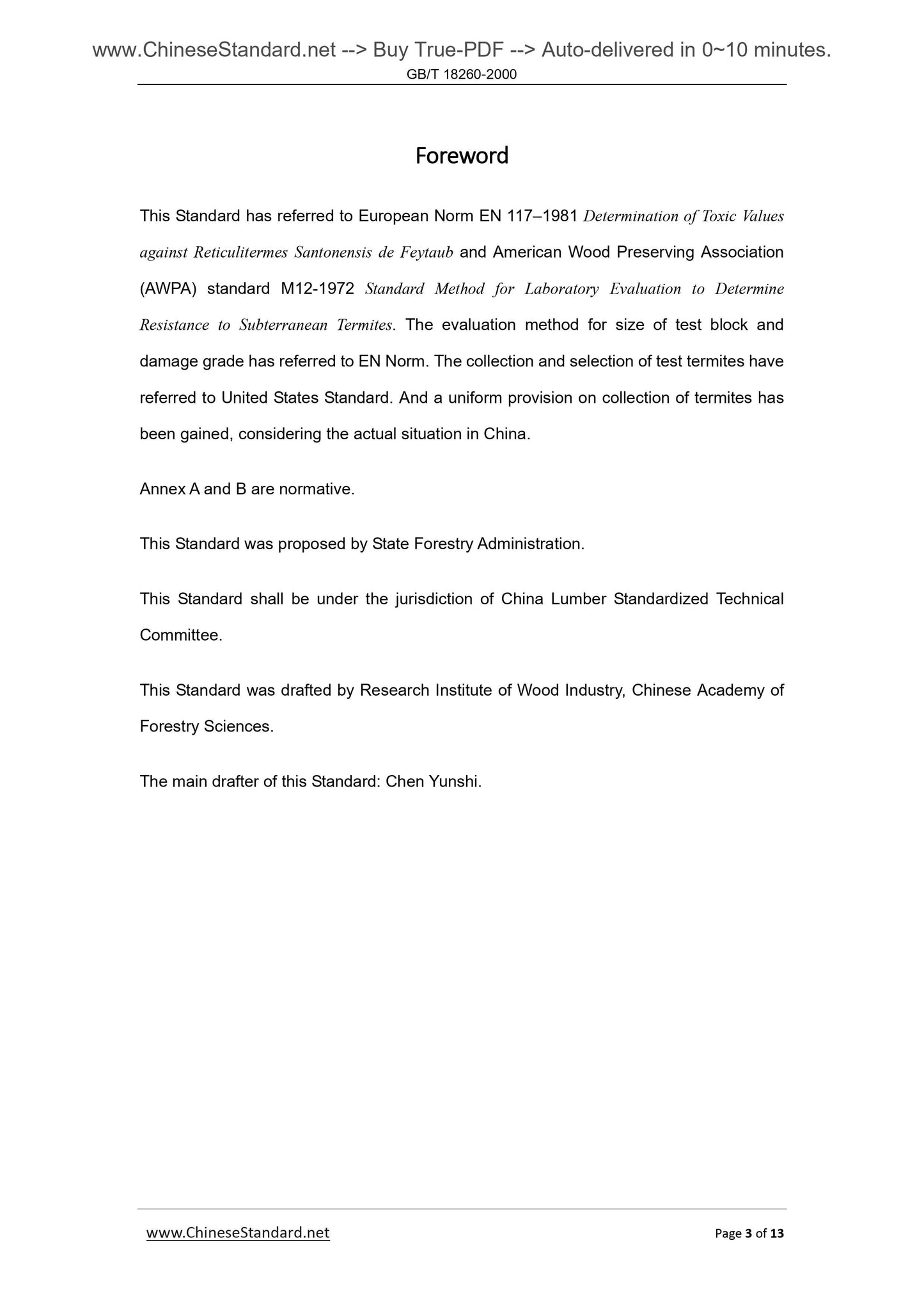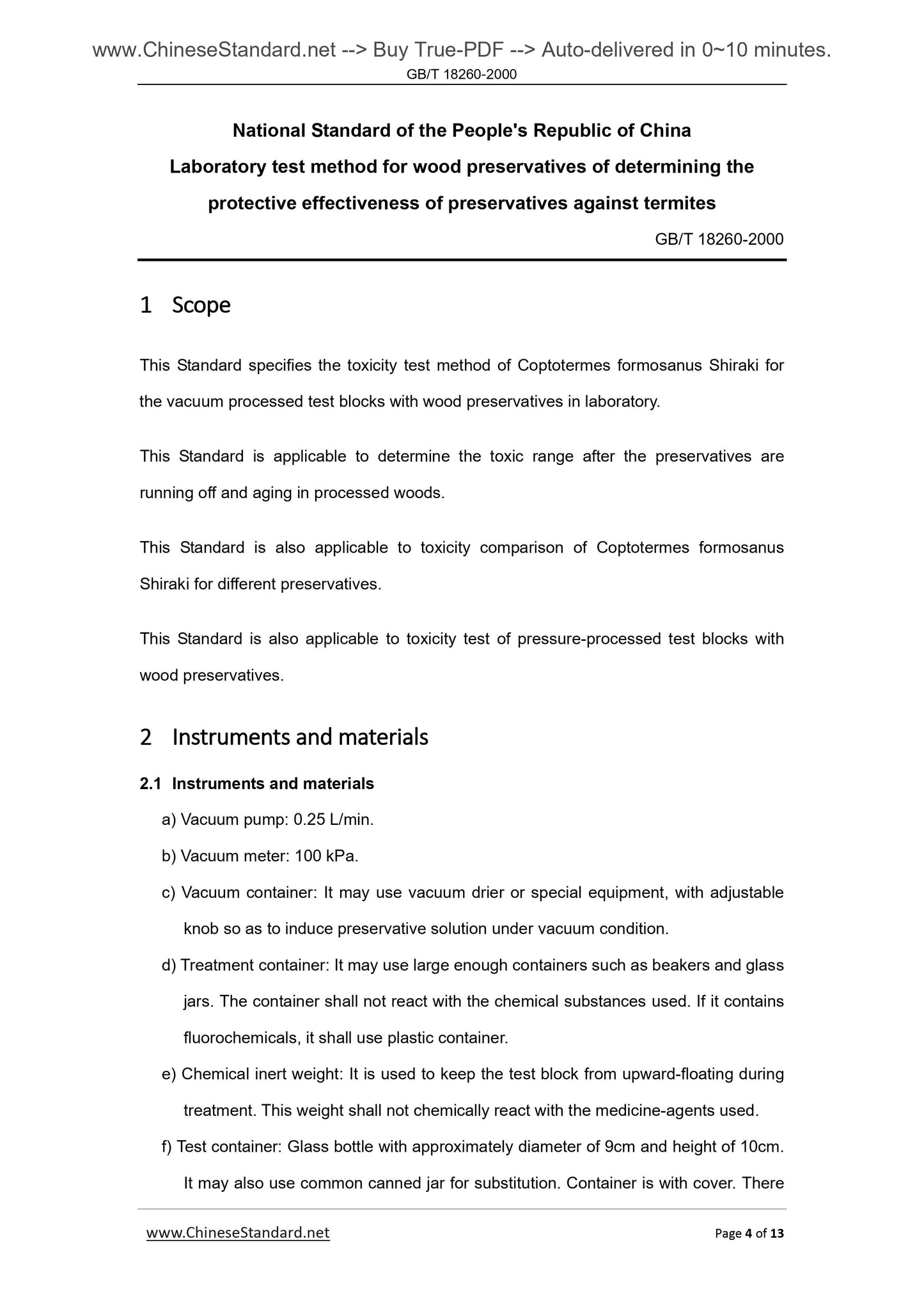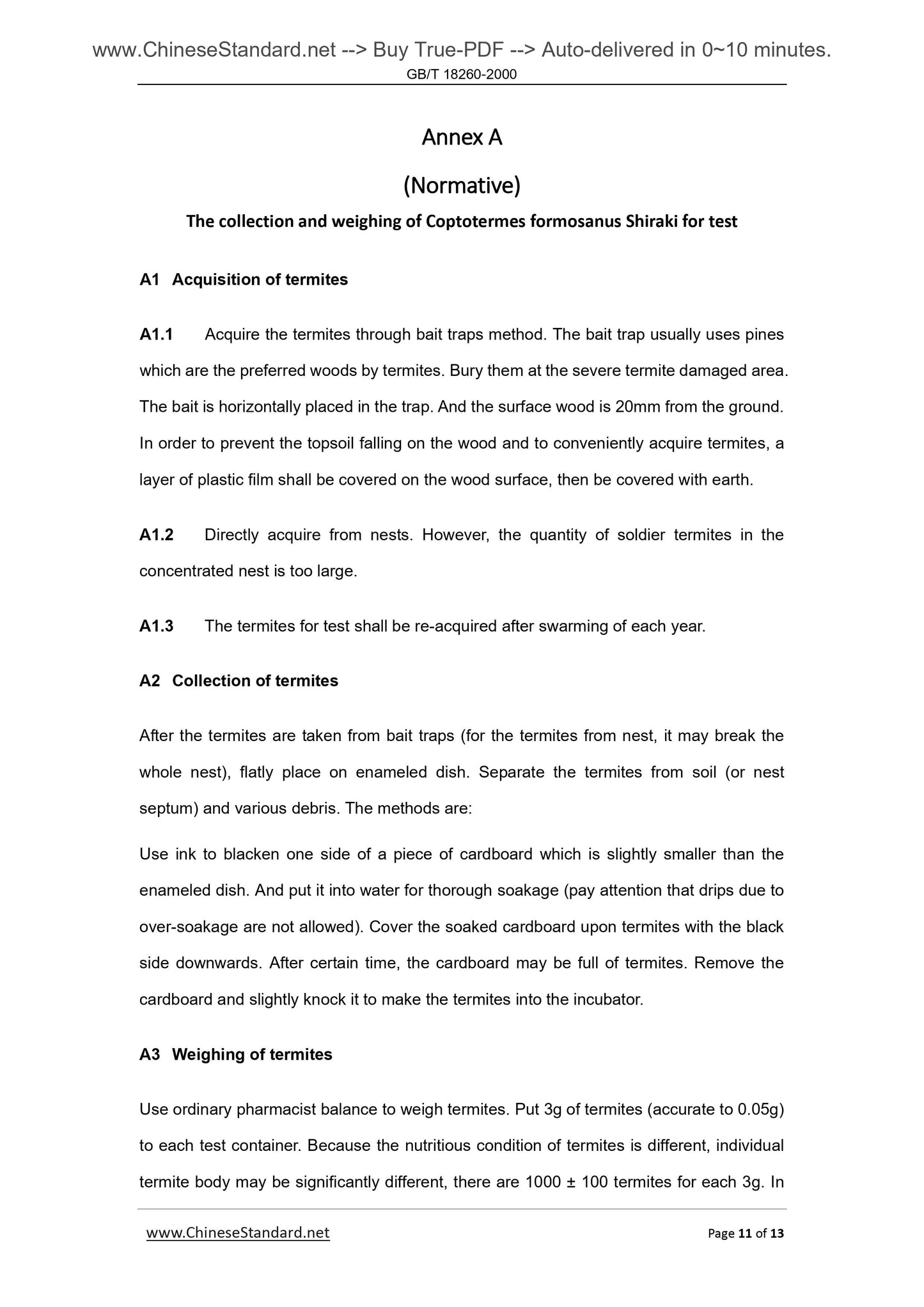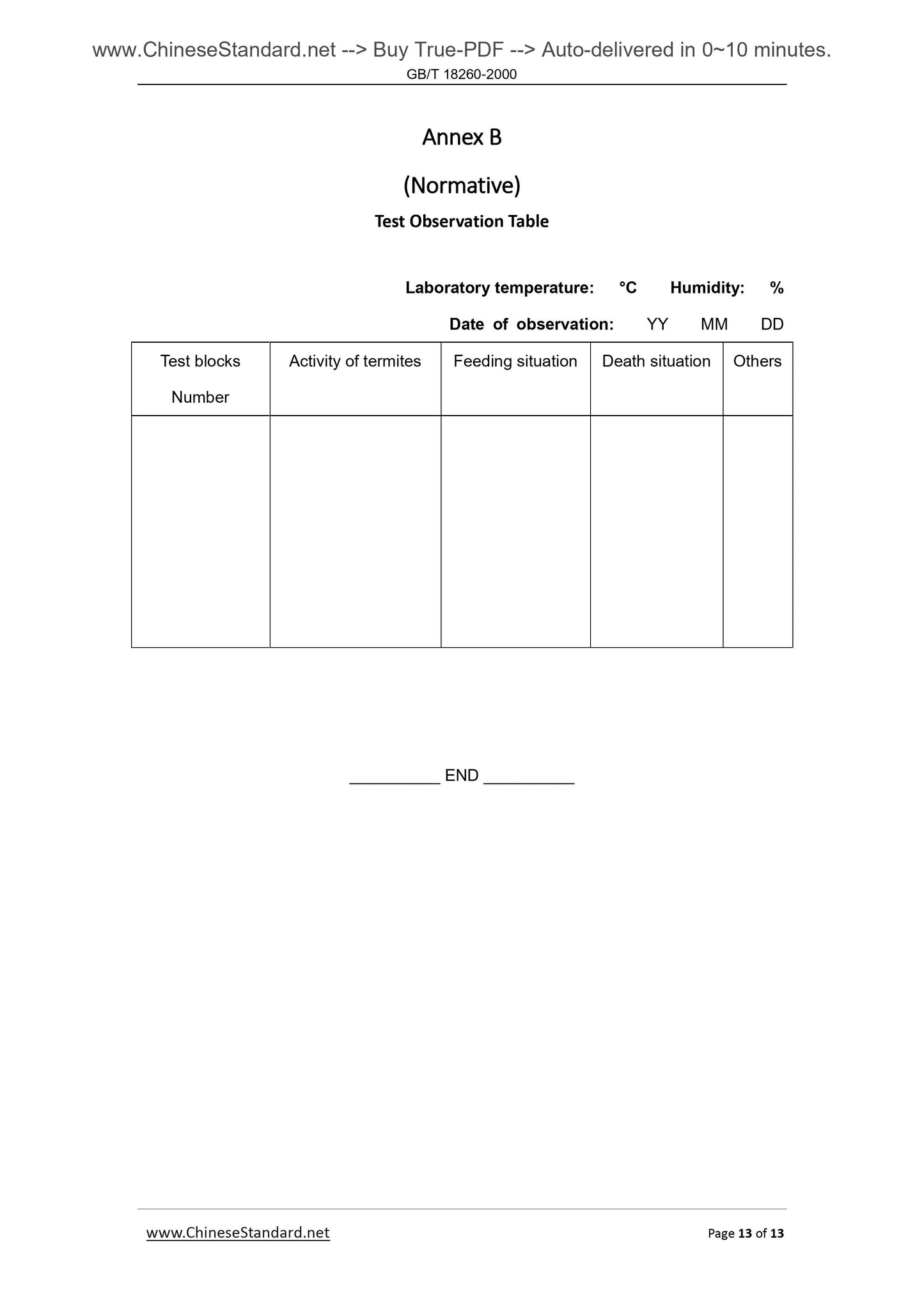1
/
su
6
PayPal, credit cards. Download editable-PDF and invoice in 1 second!
GB/T 18260-2000 English PDF (GBT18260-2000)
GB/T 18260-2000 English PDF (GBT18260-2000)
Prezzo di listino
$70.00 USD
Prezzo di listino
Prezzo scontato
$70.00 USD
Prezzo unitario
/
per
Spese di spedizione calcolate al check-out.
Impossibile caricare la disponibilità di ritiro
Delivery: 3 seconds. Download true-PDF + Invoice.
Get QUOTATION in 1-minute: Click GB/T 18260-2000
Historical versions: GB/T 18260-2000
Preview True-PDF (Reload/Scroll if blank)
GB/T 18260-2000: Laboratory test method for wood preservatives of determining the protective effectiveness of preservatives against termites
GB/T 18260-2000
GB
NATIONAL STANDARD
OF THE PEOPLE’S REPUBLIC OF CHINA
Laboratory test method for wood preservatives
of determining the protective effectiveness of
preservatives against termites
ISSUED ON. DECEMBER 04, 2000
IMPLEMENTED ON. APRIL 01, 2001
Issued by. State Bureau of Quality Technical Supervision
Table of Contents
Foreword ... 3
1 Scope ... 4
2 Instruments and materials ... 4
3 Test wood ... 5
4 Termites ... 6
5 Test methods ... 6
6 Results and evaluation ... 9
Annex A (Normative) ... 11
Annex B (Normative) ... 13
Foreword
This Standard has referred to European Norm EN 117–1981 Determination of Toxic Values
against Reticulitermes Santonensis de Feytaub and American Wood Preserving Association
(AWPA) standard M12-1972 Standard Method for Laboratory Evaluation to Determine
Resistance to Subterranean Termites. The evaluation method for size of test block and
damage grade has referred to EN Norm. The collection and selection of test termites have
referred to United States Standard. And a uniform provision on collection of termites has
been gained, considering the actual situation in China.
Annex A and B are normative.
This Standard was proposed by State Forestry Administration.
This Standard shall be under the jurisdiction of China Lumber Standardized Technical
Committee.
This Standard was drafted by Research Institute of Wood Industry, Chinese Academy of
Forestry Sciences.
The main drafter of this Standard. Chen Yunshi.
National Standard of the People's Republic of China
Laboratory test method for wood preservatives of determining the
protective effectiveness of preservatives against termites
1 Scope
This Standard specifies the toxicity test method of Coptotermes formosanus Shiraki for
the vacuum processed test blocks with wood preservatives in laboratory.
This Standard is applicable to determine the toxic range after the preservatives are
running off and aging in processed woods.
This Standard is also applicable to toxicity comparison of Coptotermes formosanus
Shiraki for different preservatives.
This Standard is also applicable to toxicity test of pressure-processed test blocks with
wood preservatives.
2 Instruments and materials
2.1 Instruments and materials
a) Vacuum pump. 0.25 L/min.
b) Vacuum meter. 100 kPa.
c) Vacuum container. It may use vacuum drier or special equipment, with adjustable
knob so as to induce preservative solution under vacuum condition.
d) Treatment container. It may use large enough containers such as beakers and glass
jars. The container shall not react with the chemical substances used. If it contains
fluorochemicals, it shall use plastic container.
e) Chemical inert weight. It is used to keep the test block from upward-floating during
treatment. This weight shall not chemically react with the medicine-agents used.
f) Test container. Glass bottle with approximately diameter of 9cm and height of 10cm.
It may also use common canned jar for substitution. Container is with cover. There
Annex A
(Normative)
The collection and weighing of Coptotermes formosanus Shiraki for test
A1 Acquisition of termites
A1.1 Acquire the termites through bait traps method. The bait trap usually uses pines
which are the preferred woods by termites. Bury them at the severe termite damaged area.
The bait is horizontally placed in the trap. And the surface wood is 20mm from the ground.
In order to prevent the topsoil falling on the wood and to conveniently acquire termites, a
layer of plastic film shall be covered on the wood surface, then be covered with earth.
A1.2 Directly acquire from nests. However, the quantity of soldier termites in the
concentrated nest is too large.
A1.3 The termites for test shall be re-acquired after swarming of each year.
A2 Collection of termites
After the termites are taken from bait traps (for the termites from nest, it may break the
whole nest), flatly place on enameled dish. Separate the termites from soil (or nest
septum) and various debris. The methods are.
Use ink to blacken one side of a piece of cardboard which is slightly smaller than the
enameled dish. And put it into water for thorough soakage (pay attention that drips due to
over-soakage are not allowed). Cover the soaked cardboard upon termites with the black
side downwards. After certain time, the cardboard may be full of termites. Remove the
cardboard and slightly knock it to make the termites into the incubator.
A3 Weighing of termites
Use ordinary pharmacist balance to weigh termites. Put 3g of termites (accurate to 0.05g)
to each test container. Because the nutritious condition of termites is different, individual
termite body may be significantly different, there are 1000 ± 100 termites for each 3g. In
Annex B
(Normative)
Test Observation Table
Laboratory temperature. °C Humidity. %
Date of observation. YY MM DD
Test blocks
Number
Activity of termites Feeding situation Death situation Others
Get QUOTATION in 1-minute: Click GB/T 18260-2000
Historical versions: GB/T 18260-2000
Preview True-PDF (Reload/Scroll if blank)
GB/T 18260-2000: Laboratory test method for wood preservatives of determining the protective effectiveness of preservatives against termites
GB/T 18260-2000
GB
NATIONAL STANDARD
OF THE PEOPLE’S REPUBLIC OF CHINA
Laboratory test method for wood preservatives
of determining the protective effectiveness of
preservatives against termites
ISSUED ON. DECEMBER 04, 2000
IMPLEMENTED ON. APRIL 01, 2001
Issued by. State Bureau of Quality Technical Supervision
Table of Contents
Foreword ... 3
1 Scope ... 4
2 Instruments and materials ... 4
3 Test wood ... 5
4 Termites ... 6
5 Test methods ... 6
6 Results and evaluation ... 9
Annex A (Normative) ... 11
Annex B (Normative) ... 13
Foreword
This Standard has referred to European Norm EN 117–1981 Determination of Toxic Values
against Reticulitermes Santonensis de Feytaub and American Wood Preserving Association
(AWPA) standard M12-1972 Standard Method for Laboratory Evaluation to Determine
Resistance to Subterranean Termites. The evaluation method for size of test block and
damage grade has referred to EN Norm. The collection and selection of test termites have
referred to United States Standard. And a uniform provision on collection of termites has
been gained, considering the actual situation in China.
Annex A and B are normative.
This Standard was proposed by State Forestry Administration.
This Standard shall be under the jurisdiction of China Lumber Standardized Technical
Committee.
This Standard was drafted by Research Institute of Wood Industry, Chinese Academy of
Forestry Sciences.
The main drafter of this Standard. Chen Yunshi.
National Standard of the People's Republic of China
Laboratory test method for wood preservatives of determining the
protective effectiveness of preservatives against termites
1 Scope
This Standard specifies the toxicity test method of Coptotermes formosanus Shiraki for
the vacuum processed test blocks with wood preservatives in laboratory.
This Standard is applicable to determine the toxic range after the preservatives are
running off and aging in processed woods.
This Standard is also applicable to toxicity comparison of Coptotermes formosanus
Shiraki for different preservatives.
This Standard is also applicable to toxicity test of pressure-processed test blocks with
wood preservatives.
2 Instruments and materials
2.1 Instruments and materials
a) Vacuum pump. 0.25 L/min.
b) Vacuum meter. 100 kPa.
c) Vacuum container. It may use vacuum drier or special equipment, with adjustable
knob so as to induce preservative solution under vacuum condition.
d) Treatment container. It may use large enough containers such as beakers and glass
jars. The container shall not react with the chemical substances used. If it contains
fluorochemicals, it shall use plastic container.
e) Chemical inert weight. It is used to keep the test block from upward-floating during
treatment. This weight shall not chemically react with the medicine-agents used.
f) Test container. Glass bottle with approximately diameter of 9cm and height of 10cm.
It may also use common canned jar for substitution. Container is with cover. There
Annex A
(Normative)
The collection and weighing of Coptotermes formosanus Shiraki for test
A1 Acquisition of termites
A1.1 Acquire the termites through bait traps method. The bait trap usually uses pines
which are the preferred woods by termites. Bury them at the severe termite damaged area.
The bait is horizontally placed in the trap. And the surface wood is 20mm from the ground.
In order to prevent the topsoil falling on the wood and to conveniently acquire termites, a
layer of plastic film shall be covered on the wood surface, then be covered with earth.
A1.2 Directly acquire from nests. However, the quantity of soldier termites in the
concentrated nest is too large.
A1.3 The termites for test shall be re-acquired after swarming of each year.
A2 Collection of termites
After the termites are taken from bait traps (for the termites from nest, it may break the
whole nest), flatly place on enameled dish. Separate the termites from soil (or nest
septum) and various debris. The methods are.
Use ink to blacken one side of a piece of cardboard which is slightly smaller than the
enameled dish. And put it into water for thorough soakage (pay attention that drips due to
over-soakage are not allowed). Cover the soaked cardboard upon termites with the black
side downwards. After certain time, the cardboard may be full of termites. Remove the
cardboard and slightly knock it to make the termites into the incubator.
A3 Weighing of termites
Use ordinary pharmacist balance to weigh termites. Put 3g of termites (accurate to 0.05g)
to each test container. Because the nutritious condition of termites is different, individual
termite body may be significantly different, there are 1000 ± 100 termites for each 3g. In
Annex B
(Normative)
Test Observation Table
Laboratory temperature. °C Humidity. %
Date of observation. YY MM DD
Test blocks
Number
Activity of termites Feeding situation Death situation Others
Share
